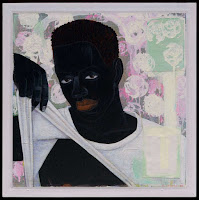 |
| "Purple Robe and Anemones" (1937) |
The featured exhibit was Matisse in the Studio (with the catchphrase "inspiration is everywhere.") It's a wonderful show featuring objects Matisse incorporated into his paintings side by side with the artwork. He described his objects as "a working library," a set of reference tools akin to the dusty tomes a scholar would have on her shelves.
The pewter pitcher shown in the foreground of "Purple Robe and Anemones" was one item on display. Its undulating lines are repeated throughout the painting in what the MFA refers to as a "call and response." The exhibit also included an elaborately painted table with intertwining lines similar to the one shown in this work.
 |
| Egyptian Curtain |
No supposition is required as to the more direct inspiration of this curtain. In his "Interior with Egyptian Curtain," painted in 1948, Matisse showcases the wall hanging. The movement feels reminiscent of his "Dance" paintings created nearly 40 years earlier.
 |
| "Interior with Egyptian Curtain" |
While I could have spent all my allotted time enjoying the Matisse exhibit, there was much more to see at the MFA. It was fun to explore the Museum's somewhat convoluted space, popping into rooms that piqued my interest.
These ramblings introduced me to several artists with whom I was not familiar. I was drawn to the work of American artist Charles Sheeler. The clean, crisp lines of his paintings gave them a graphic feel. He was part of the Precisionist school of art, a movement I'd never heard of before. The style, which came into being post-World War I, is considered the first contribution to Modernism by American artists.
 |
| Sheeler's "View of New York" |
I enjoyed learning the story behind Sheeler's "View of New York." Before turning to painting, Sheeler was a commercial photographer of some renown. This work bridges the two worlds with its painted images of the life he's left behind. His camera is draped, and the light is off. The chair in which a model might sit is turned away from the camera. Its stillness captures the artist's contemplative mood.
 |
| Marshall's "Superstar" (1994) |
While the painting captured my interest without any commentary, it does carry a political message. "The whole history of representation is built on the representation of white folks," Marshall has said. "I call attention to the absence of black presence." It's kind of hard to argue with his point.
 |
"I Dreamed I Could
Fly" by Borofsky
|
All too soon, my visit came to an end. Since 30 years has passed since I last found myself in Boston, I suspect I won't be back any time soon. But if I do, you can be assured that I'll make a beeline straight for the MFA.



No comments:
Post a Comment